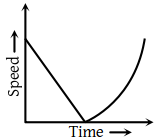In the following graph, the distance travelled by the body in metres is:

1.
\(200\)
2.
\(250\)
3.
\(300\)
4.
\(400\)

Velocity-time curve for a body projected vertically upwards is
1. Parabola
2. Ellipse
3. Hyperbola
4. Straight line
The displacement-time graph of a moving particle is shown below. The instantaneous velocity of the particle is negative at the point
1. D
2. F
3. C
4. E
An object is moving with a uniform acceleration which is parallel to its instantaneous direction of motion. The displacement (s) – velocity (v) graph of this object is
| 1. |  |
| 2. |  |
| 3. |  |
| 4. |  |
Which of the following graph represents uniform motion ?
| 1. |  |
| 2. |  |
| 3. |  |
| 4. |  |
A ball is dropped vertically from a height \(d\) above the ground. It hits the ground and bounces up vertically to a height \(d/2.\) Neglecting subsequent motion and air resistance, its velocity \(v\) varies with the height \(h\) above the ground is:
| 1. |  |
| 2. |  |
| 3. |  |
| 4. |  |
The graph of displacement v/s time is
Its corresponding velocity-time graph will be
1. 
3. 
A train moves from one station to another in 2 hours time. Its speed-time graph during this motion is shown in the figure. The maximum acceleration during the journey is
1. \(140\) km h-2
2. \(160\) km h-2
3. \(100\) km h-2
4. \(120\) km h-2
A ball is thrown vertically upwards. Which of the following plots represents the speed-time graph of the ball during its height if the air resistance is not ignored?
| 1. |  |
| 2. |  |
| 3. |  |
| 4. |  |
Which graph represents a uniformly accelerated motion?
| 1. |  |
2. |  |
| 3. |  |
4. |  |











